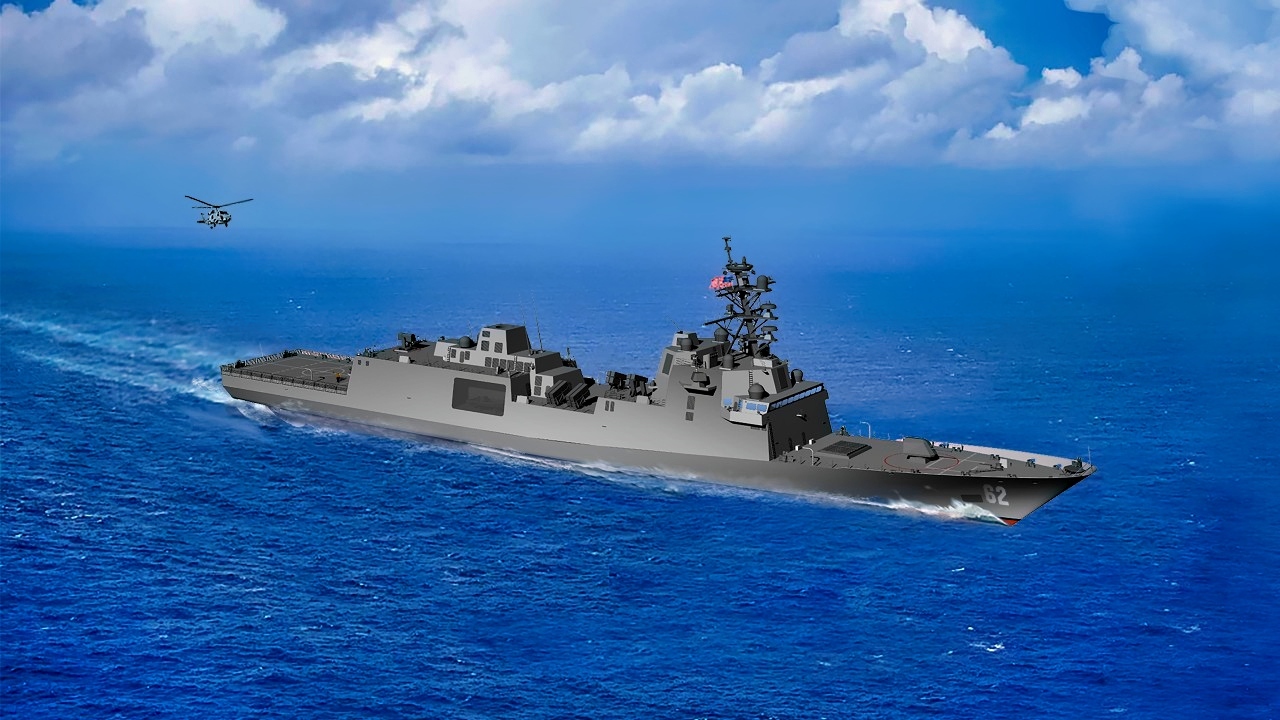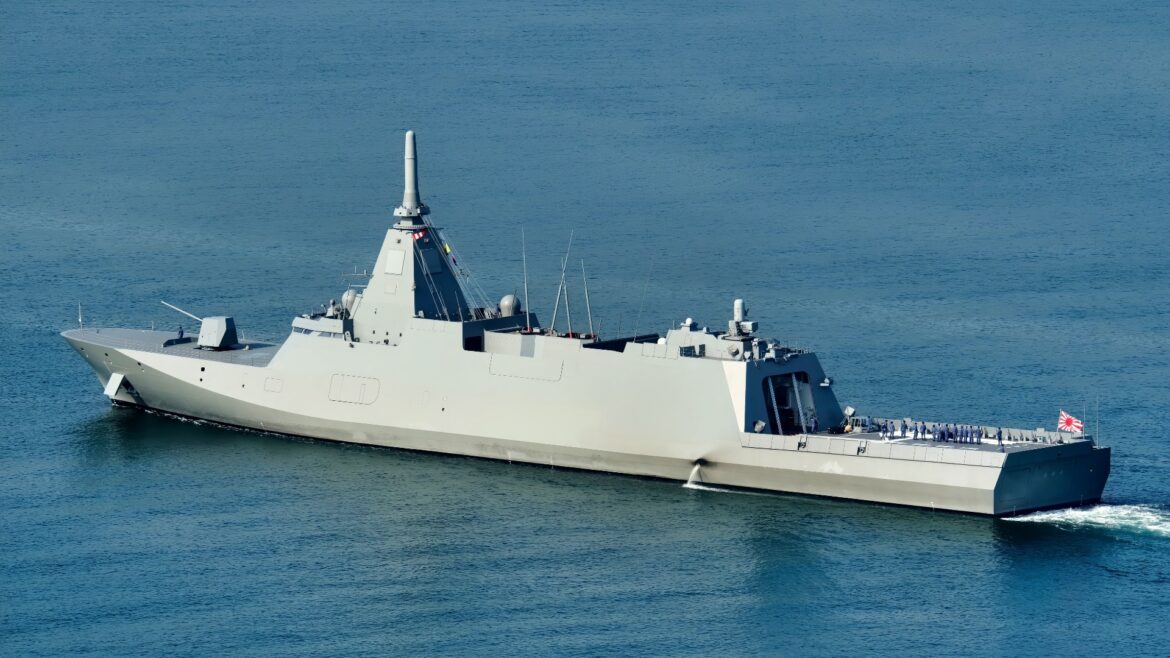Key Points and Summary – Australia’s August deal to buy 11 advanced Mogami-class frigates from Japan serves as a stark wake-up call for the dire state of U.S. shipbuilding.
-The contrast is telling: while Japan has rapidly built eight Mogami frigates since 2019, the U.S. Navy’s own Constellation-class frigate is years behind schedule.

An artist rendering of the U.S. Navy guided-missile frigate FFG(X). The new small surface combatant will have multi-mission capability to conduct air warfare, anti-submarine warfare, surface warfare, electronic warfare, and information operations. The design is based on the FREMM multipurpose frigate. A contract for ten ships was awarded to Marinette Marine Corporation, Wisconsin (USA), on 30 April 2020.
-The first Australian Mogami may even be delivered before the first U.S. Constellation is commissioned.
-The deal reveals that the U.S. is not only falling behind in shipbuilding speed but is no longer even a contender in the high-end warship export market.
The Mogami-Class Is Coming to Australia
Australia in August inked a deal to purchase 11 new frigates from Japan. The sale was noteworthy not only for the hypermodern construction and look of the new warships. It also marked a massive step by Japan into the high-end warship export market.

An artist rendering of the U.S. Navy guided-missile frigate FFG(X). The new small surface combatant will have multi-mission capability to conduct air warfare, anti-submarine warfare, surface warfare, electronic warfare, and information operations. The design is based on the FREMM multipurpose frigate. A contract for ten ships was awarded to Marinette Marine Corporation, Wisconsin (USA), on 30 April 2020.
The U.S. Navy should take note and think hard about how it is possible for Japan to build and design modern warships so rapidly, while U.S. projects languish in an extended purgatory of endless redesigns.
What Are They?
The Mogami-class vessels Australia purchased are mid-sized modern frigates, displacing 5,500 tons with an overall length of 435 feet.
They can make more than 30 knots on the strength of a Rolls Royce gas turbine. The ships carry a 16-cell vertical launch system that will likely carry both anti-air and anti-surface weapons.
The ships are also equipped with missile canisters carrying a total of eight Japanese Type-17 anti-ship missiles, each with a range of up to 400 kilometers. (Future modifications may extend this range.) The ships are sleek, stealthy, and highly automated, requiring 90 or so crewmen under normal conditions.
An extensive sensor suite is integrated by a world-class command-and-control center.
Why Does Australia Want Them?
The Mogamis will replace Australia’s eight Anzac-class frigates, which have been in service since the late 1990s.
Australia also accepted bids from Germany, South Korea, and Spain, with Germany and Japan making it to the second round.
As with most modern defense export deals, the agreement involves a transfer of technology and know-how from Japan to Australia. Japanese yards will build the first three vessels, with Australia building the remaining eight in its own shipyards.
The ships are a huge upgrade over the Anzacs and will give Australia a credible anti-air and anti-surface capability in a Pacific theater that has grown more crowded and more dangerous.
The Mogamis are larger, faster, more heavily armed, and require smaller crews — a key detail for a Royal Australian Navy starved for personnel. The deal will also jumpstart Australia’s military shipbuilding industry, a goal held dear by successive Australian governments.
How Does this Impact the U.S.?
The export of an advanced warship from one U.S. ally to another would not seem to signal a crisis for the United States.
Indeed, the U.S. alliance network is intended to become more flexible and self-sustaining, with the United States providing an environment in which allies can defend themselves against potential aggressors.
The problem is that the United States was not even conceptually capable of making a deal of this sort with Australia.
The United States no longer exports warships, in part to protect critical technology, in part because of shipbuilding constraints, and in part because the U.S. Navy’s ships are too worn out at the end of their service lives to contemplate using in another navy.
These constraints have made it difficult to live up to the terms of the AUKUS agreement, which envisions the transfer of Virginia-class submarines to Australia.
What Happens Now?
Japan laid down the first Mogami in 2019. Eight are currently in service with the Japanese Maritime Self-Defense Force, with four more expected to join within the next two years.
A deal for the export of a further four frigates to Indonesia fell through last year.
By contrast, the U.S. Navy expected to lay down its first Constellation-class frigate in 2020.
The Constellation was finally laid down in 2024, remains the only frigate under construction, and is not expected to enter service until 2029. The first Australian Mogami is scheduled for delivery in 2029 — possibly before the first Constellation sees a bottle of champagne.
There are reasons why the Constellations have been so slow to arrive and the Mogamis so fast, but none of them should serve as excuses for the perilous state of American shipbuilding.
The United States may never find its way back into the global export market for high-end warships.
Still, the Navy absolutely needs to do something about the fact that other major shipbuilders are leaving the United States in their distant wake.
About the Author: Dr. Robert Farley
Dr. Robert Farley has taught security and diplomacy courses at the Patterson School since 2005. He received his BS from the University of Oregon in 1997, and his Ph. D. from the University of Washington in 2004. Dr. Farley is the author of Grounded: The Case for Abolishing the United States Air Force (University Press of Kentucky, 2014), the Battleship Book (Wildside, 2016), Patents for Power: Intellectual Property Law and the Diffusion of Military Technology (University of Chicago, 2020), and most recently Waging War with Gold: National Security and the Finance Domain Across the Ages (Lynne Rienner, 2023). He has contributed extensively to a number of journals and magazines, including the National Interest, the Diplomat: APAC, World Politics Review, and the American Prospect. Dr. Farley is also a founder and senior editor of Lawyers, Guns and Money.
More Military
Merkava: The Best Tank on Earth (Not Made in USA)
The U.S. Air Force’s Big B-21 Raider Stealth Bomber Mistake Still Stings
The U.S. Navy’s Big Ford-Class Aircraft Carrier Mistake Still Stings
Russia’s Admiral Kuznetsov Aircraft Carrier Can’t Stop Pumping Out Toxic Black Smoke
India’s Big Blunder Purchase of Russia’s ‘Mothball’ Aircraft Carrier Still Stings


AloJapan.com